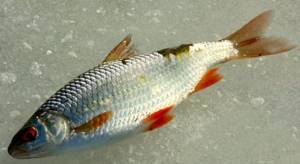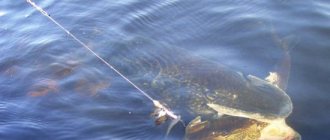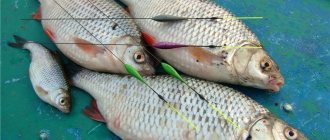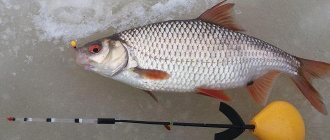Roach fish - description
The common roach has many names. It is also called roach, ram, sorogo, roach, chebak. These are all the same species, distributed over most of the continent of Eurasia. The roach belongs to the carp family, but even a beginner will not confuse it with its closest relatives due to some external features. Let's list the main ones:
Oblong body with a smooth narrowing in the tail;- Dark back with a greenish tint;
- Silvery sides, covered with fairly large, tightly packed scales;
- Light belly;
- The lower fins have an orange-red tint, the caudal and dorsal fins are darker;
- Bright red eyes (one of the main differences).
The roach grows up to 50 cm, but the catches are dominated by specimens from 10 to 25 cm in length. The average weight of an adult is 200-300 g. This fish is interesting because you can never predict the result. Small and medium roach can be caught, and sometimes trophies are pecked one after another. Some fishermen claim that they managed to catch a 1.5-kilogram sorog, but this happens extremely rarely.
Origin of the species and description

The common roach is a representative of the class of ray-finned fish, belonging to the carp family and the order Cypriniformes. The fish is characterized by a large number of subspecies, which have their own names.
In the vastness of Siberia and the Urals, the roach is called the chebak, which has an elongated narrow body and yellow eyes. The length of the chebak’s body can reach up to 32 cm, and its weight – up to 760 grams. In the Kirov, Arkhangelsk, Vologda regions and on the territory of the Nenets Autonomous Okrug, the roach is called the roach, the fish has red eyes and a body wider in shape than that of the chebak.
Video: Roach
On Baikal and in the Yenisei basin you can hear the name of roach as sorozhka. Vobla can be found in the vastness of the Caspian Sea; during spawning, it enters the Volga, the length of the fish does not exceed 30 cm. The ram lives in the waters of the Azov and Black Seas, entering the beds of flowing rivers during the spawning period. The greatest length of her body is 35 cm, and her weight is about two kilograms.
Freshwater roach is called vein roach, and fish inhabiting brackish waters is called semi-anadromous. Among the residential species, the most valuable is the Siberian roach (chebak), which is harvested on an industrial scale. Such semi-anadromous subspecies as ram and roach are also of commercial importance.
Interesting fact: There is still debate among scientists regarding the identification of varieties and subspecies of roach. Some believe that dividing this fish into subspecies is wrong, others, on the contrary, consider some of the subspecies to be separate, separate species.
Behavior and habitats
Roach is a schooling fish. As a rule, individuals of approximately the same age and size gather in one group, but exceptions occur. The formation of a flock is influenced by factors such as the size of the reservoir, food supply, and others. Groups in which medium and large individuals predominate stay in deeper areas, while small fish prefer shallow coastal waters. This fish loves places overgrown with reeds, reeds and other aquatic vegetation, often standing on the border between grass and clean water. In general, it is unpretentious and feels great in a variety of conditions, both on the current and in quiet river bays. The only thing it vitally needs is a sufficient level of oxygen in the water.

With the onset of spring, which brings the first warmth, the roach leaves great depths and rises upstream to the spawning grounds. Along the way, it actively feeds, delighting fishermen with a good bite. Spawning begins around mid-April and lasts several weeks. In some regions, depending on weather conditions (primarily temperature indicators), the spawning process may begin earlier or later.
In summer, this fish is active around the clock. Since water bodies abound in algae and living organisms during the warm period, she has no problems with food. Because of this, it becomes much more difficult to catch it; it often ignores fishing baits. However, closer to mid-autumn the picture changes. The vegetation gradually begins to sink and die, living creatures hide in the bottom soil, so the roach stops being picky. Now it’s easy to catch even for a beginner, using any bait or attachment.
In October, this fish gathers in large groups and moves from shallow water to depth. But unlike many of its relatives, such as bream, it does not remain half asleep in wintering pits all winter. On the contrary, roach remains active during the cold period. It can be effectively caught in winter only in deep areas, preferably with the remains of aquatic plants at the bottom.
Where it lives: sea or river
Resident roach is a freshwater, semi-anadromous species found in brackish waters.
The silver fish grows in the Eurasian part in almost all lakes, estuaries, reservoirs, and canals, from Scandinavia to the Mediterranean.

In the Central part of Russia, in Siberia, in the Urals, with the exception of the Far East (it is not there), it has chosen:
- Kola Peninsula (Lovozero, Imandra, Ponoy River),
- Karelia (Syamozero, Vygozero, Segozero and others),
- rivers flowing into the Arctic Ocean,
- Seyakha River (Yamal Peninsula),
- reservoirs of the Urals,
- river basins of the Black and Azov Seas (except Crimea),
- river systems of the Aral Sea,
- river basins of the Altai Mountains,
- Baikal.
The roach's habitat is freshwater, with a slow current. It lives in schools in creeks, backwaters, reaches, oxbow lakes and other biotopes with dense vegetation and a muddy bottom. It constantly drifts along their borders and hides in them when there is danger.
Important! In technogenically polluted lakes with melt and rainwater from urban areas, roaches are caught whose modified skeleton structure looks abnormal: 14 rays in the dorsal fin, two rows of pharyngeal teeth, with additional links in the spine. This means that a new morphotype of fish is being formed.
Diet and choice of bait
In the warm season, the main food of the roach is young vegetation, and in the cold season, various living creatures predominate in its daily menu. Protein-containing food of animal origin is especially necessary for her in early spring, when she is preparing for the upcoming spawning. At the same time, in search of insects and larvae, roach does not rummage through bottom sediments, as many other species do. She looks for worm bugs in the water column, on plant stems, or simply catches zooplankton driven by the current.

From all this it follows that for fishing it is necessary to select bait according to the season. What to use to catch roach? In winter, spring and late autumn she will hunt for bloodworms, mayflies, maggots, and worms. And in the summer it is better to offer her something vegetable - dough, semolina mash, bread crumb, steamed barley, and so on. If we are talking about trophy fishing, then you can safely put canned corn or peas on the hook. Sometimes so-called sandwiches are “shot” from two completely different baits. For example, maggot + pearl barley. The fly larva attracts the fish with its activity on the hook, and the steamed aromatic grain makes you want to quickly eat it all, before other members of the flock notice the delicacy.
At the very end of spring, experienced fishermen use filamentous algae (in fishing parlance - brilliant green) as bait.
This herb, rich in vitamins and microelements, is very popular with roaches, as evidenced by the contents of the stomachs of gutted fish. You can find such a nozzle on stones and supports of hydraulic structures.
Roach spawning
The beginning of roach spawning depends on a single factor - water temperature. The faster it warms up to 12 degrees, the sooner this fish will begin to spawn. In some years, this process begins as early as the end of March, but this does not happen often. The duration of spawning is affected by weather conditions. If the weather presents a surprise in the form of a sharp drop in air temperature, the roach will pause the process of laying eggs and will continue it only with the next warming.

Before spawning, the fish actively feeds, grabbing everything that its digestive system can digest. Procreation is a grueling task that requires a lot of energy and strength. 12-15 days before spawning, males become covered with miniature hard pimples, which are clearly visible and felt by hand. If such specimens begin to come across, this means only one thing: within a week the bite will disappear. For spawning, roach choose oxbow lakes, creeks and other secluded corners of the reservoir, laying eggs in quiet areas where the depth does not exceed 25 cm.
What class and order does it belong to?
The description of the species - common roach - is constructed as follows:
- superkingdom - eukaryotes (nucleated cells),
- kingdom - animals
- subkingdom - eumetazoans (true multicellular organisms),
- bilateria (bilaterally symmetrical) - there is a body axis,
- deuterostomes,
- type - chordates,
- subtype - vertebrates,
- infratype (group) - gnathostomes,
- clade (a group with a common ancestor and all its descendants) - fish,
- superclass - bony fishes,
- class - ray-finned,
- subclass - new feathers,
- infraclass - bony,
- superorder - osteovesical (there is a Weberian apparatus that connects the swim bladder to the inner ear),
- series - ostariophysics,
- order - carp-like,
- superfamily - carp-like,
- family - carp (Cyprinidae),
- subfamily - Leuciscinae (true minnows),
- genus - roach,
- species - roach.
International scientific name Rutilus rutilus (Linnaeus, 1758). The name was given by the Swedish biologist Carl von Linnaeus, who formed the binomial system in which living things are given double names.
It's exciting! There are Spanish, Shirvan, Alpine, Italian and other tracks in the world.
Roach fishing
It was already mentioned above that roach is caught throughout the year. In winter, on rivers and lakes, especially large ones, it is much more difficult to find it than in summer. It can be located both in depth and shallow, in the coastal zone. During the warm period, the task is simplified, since the fish spends most of its time mainly in areas with vegetation. And since there is always more grass near the shore, it is more advisable to fish with float tackle. This can be a fly rod, a plug rod for fishing for too shy roach, a Bolognese or a match rod for fishing in places where you need to cast the bait further. Let's look at the nuances of such fishing using the example of ordinary fly gear.

A fishing rod with a blind rig is a mobile and very effective tackle, and therefore the most popular in roach fishing. Depending on the conditions on a particular body of water, the length of the rod can vary from 3 to 7 meters. In any case, it should be thin, light and easy to use.
The equipment used is as delicate as possible. The diameter of the main line usually does not exceed 0.18 mm, and the thickness of the leader reaches 0.08 mm. Of course, this can be torn off even when fishing for a small fish, so it is better to use a 15-centimeter leash with a cross-section of 0.10 or 0.12 mm, and let professionals use monofilament thinner than a hair. The hook is selected for a specific nozzle, or rather its size. If you are going to fish with a worm, then a hook with a longer shank No. 6-7 according to the domestic classification is suitable. The same numbers, but with a short shank, can be used when fishing with canned corn and peas. For bloodworms, maggots, semolina, dough and other small baits, it is advisable to use a smaller hook - No. 4, 5.
The bite alarm is a spindle-shaped float with a long keel, a bright antenna and two attachment points. The recommended load capacity in still water is 1-2 g, in flowing water - from 3 to 6 g, depending on the strength of the water flow. When using larger floats and, accordingly, heavier loads, the bait, after casting, will quickly reach the specified fishing horizon, thereby cutting off the annoying bleak. For the same purpose, it is advisable to distribute a load of several pellets along the main line so that the heavy weights are closer to the hook.

Do I need to feed roaches? If you manage to find an actively feeding school, then you can do without bait, but in any case, its use will increase the fishing efficiency. The fish are fed with various cakes (sunflower, hemp), porridges, the basis of which can be millet, pearl barley or peas, and special store-bought mixtures. When fishing in cold water (spring, autumn), animal components must be added to the bait. There should be no dusty components in the bait, otherwise they will attract bleak and other small things.
A roach bite is signaled by a smooth movement of the float to the side or under the water. It is at this second that you need to hook. A specimen weighing 300 g or more will provide quite strong resistance. It should be brought out carefully, without forcing events; haste at such moments often leads to the breakage of the thin leash.
Where to Look for Roach in Estuaries
In small rivers, in places where they flow into large rivers or reservoirs, you should start looking for roach no earlier than mid-February. This is under conditions that the winter is warm, thereby attracting roaches with a stream of fresh water.
But under no circumstances should this force you into rigid boundaries. According to our observations, a large concentration of roach was noticed both closer to the mouth and 1-2 km away. from the confluence of the river.
There are a huge number of favorable and promising places for roach, for example places with steep banks, as we wrote about above. Here you need to take into account everything, every detail, as well as the convenience of the fisherman.
3 ways to improve your fish bite!

Over 15 years of active fishing, I have found many ways to improve the bite, and here are the most effective:
1. Bite activator . This pheromone additive attracts fish most strongly in cold and warm water. The Fish Hungry bite activator has proven itself to be excellent - Read more…
2. Tackle with increased sensitivity . You should first familiarize yourself with the features of using a particular type.
3. Pheromone baits . They attract the attention of fish, stimulate hunger and cause a schooling reflex, which allows you to collect a lot of fish in one place.
You can get the rest of the secrets of successful fishing for free by reading my other materials on the site.
3 ways to improve your fish bite!
Over 15 years of active fishing, I have found many ways to improve the bite, and here are the most effective:
1. Bite activator . This pheromone additive attracts fish most strongly in cold and warm water. The Fish Hungry bite activator has proven itself to be excellent - Read more…
2. Tackle with increased sensitivity . You should first familiarize yourself with the features of using a particular type.
3. Pheromone baits . They attract the attention of fish, stimulate hunger and cause a schooling reflex, which allows you to collect a lot of fish in one place.
You can get the rest of the secrets of successful fishing for free by reading my other materials on the site.
For example, when there is a strong wind, sitting at the mouths of rivers is not very comfortable, so it is best to look for roach near steep banks.

Cooking recipes
Many fishermen successfully catch this fish, but few of them know how to cook roach? By and large, they don’t need this, because the wives do the cooking. Here are some interesting recipes.

The simplest dish is roach cutlets. Since this fish is small, it is not at all necessary to remove bones from it; it is enough to remove the entrails, wash it, and cut off the head and fins. The carcasses prepared in this way are passed through a meat grinder several times, after which a little lard (1:6), a couple of slices of a soaked loaf, an egg, chopped onion and garlic, ground pepper, and salt are added to the resulting minced meat. The amount of the last four ingredients is to taste. Cooking consists of three stages. First, you need to form cutlets from the minced meat, then roll the pieces in breadcrumbs and fry on both sides over low heat using vegetable oil. Each side takes approximately 4-5 minutes. When the roach cutlets acquire a golden crust, they can be removed.
Another fish delicacy is dried roach, especially if it contains caviar. To do this, take fish weighing up to 0.5 kg. In the spring, you don’t have to gut it, since there is no greenery in the stomach at this time of year, which gives a bitter taste. The fish, washed from mucus, is first salted in an enamel container, generously sprinkling each row of carcasses with coarse salt. To make them better salted, place a plate on top, and place a heavy load (a brick or a jar of water) on it. After 2 days of salting, the fish is soaked in cold water for 2-3 hours. When the fish starts to float, it means it’s time to take it out of the water and prepare it for drying, namely, dip it in a solution of 3 percent vinegar, the purpose of which is to repel flies. Roach is dried in the open air at a temperature of 18-20 degrees. Depending on its size, this may take from 1 to 4 weeks. After this, it should “ripen” for the same amount of time in a fabric bag in a cool room.

Roach baked on coals turns out to be very tasty. As they say, in nature and with smoke. You can cook it this way right on the banks of a river or lake. To do this, the fish is cleaned, the gills are removed, washed and cut into portions. Rub each piece with salt and pepper, add a little butter and wrap it in foil. In this form, they are buried in hot ashes so that the smoldering coals are on top. Half an hour of tedious waiting, and the dish is ready! The “smoky” fish can be decorated with herbs, and the best side dish for it is considered to be jacket potatoes baked in the same way.
Video on the topic:
Catching roach with a fishing rod in spring. Large roach on a float in April
14:47
How to properly dry fish. How to deliciously dry roach. The easiest way
15:06
Fishing in the spring on a small river. Catching roach a meter from the shore
12:49
Roach cutlets
09:32
narybalke











